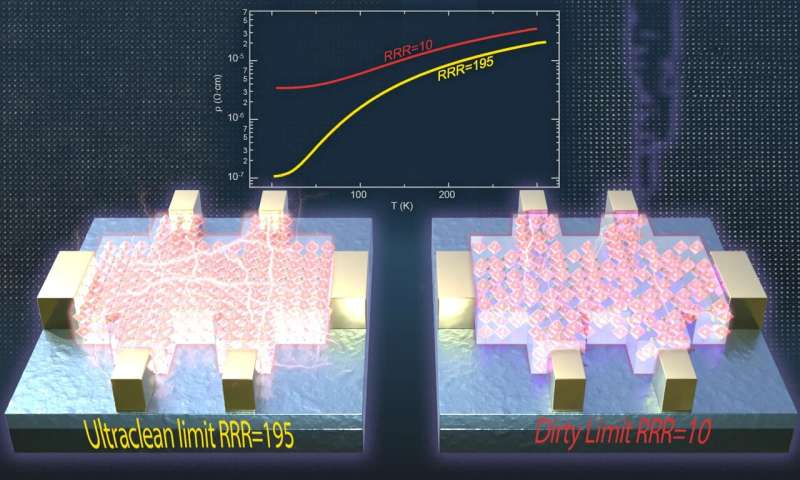This article has been reviewed according to Science X's editorial process and policies. Editors have highlighted the following attributes while ensuring the content's credibility:
fact-checked
peer-reviewed publication
trusted source
proofread
New research uncovers hidden phenomena in ultra-clean quantum materials

In a paper published today in Nature Communications, researchers unveiled previously unobserved phenomena in an ultra-clean sample of the correlated metal SrVO3. The study offers experimental insights that challenge the prevailing theoretical models of these unusual metals.
The international research team—from the Paul Drude Institute of Solid State Electronics (PDI), Germany; Oak Ridge National Laboratory (ORNL); Pennsylvania State University; University of Pittsburgh; the Pittsburgh Quantum Institute; and University of Minnesota—believes their findings will prompt a re-evaluation of current theories on electron correlation effects, shedding light on the origins of valuable phenomena in these systems, including magnetic properties, high-temperature superconductivity, and the unique characteristics of highly unusual transparent metals.
The perovskite oxide material SrVO3 is classified as a Fermi liquid—a state describing a system of interacting electrons in a metal at sufficiently low temperatures.
In conventional metals, electrons that conduct electricity move independently, commonly referred to as a Fermi gas. In contrast, Fermi liquids feature significant mutual interactions between electrons, meaning the motion of one electron strongly influences the others. This collective behavior can lead to unique electronic properties with profound technological applications, providing insights into the interactions between electrons in correlated metals.
SrVO3 serves as an ideal model system for studying electron correlation phenomena due to its crystalline and electronic simplicity. This simplicity is crucial for understanding complex phenomena such as magnetic order or superconductivity, which can complicate theoretical and experimental studies.
Another crucial factor in understanding experimental results that guide theoretical models for electron correlation effects is the presence or absence of defects in the material itself. Dr. Roman Engel-Herbert, study lead and Director of PDI in Berlin, said, "If you want to get to the bottom of one of the best-kept secrets in condensed matter physics, then you must study it in its purest form; in the absence of any extrinsic disturbance. High-quality materials that are virtually defect-free are essential. You need to synthesize ultra-clean materials."
Achieving a defect-free sample of SrVO3 has been a seemingly insurmountable challenge until now. By employing an innovative thin film growth technique that combines the advantages of molecular beam epitaxy and chemical vapor deposition, the team achieved an unprecedented level of material purity.
Dr. Matt Brahlek, first author of the study, quantifies the improvement: "A simple measure of material purity is the ratio of how easily electricity flows at room temperature compared to low temperature, called the residual resistivity ratio, RRR value. If the metal contains many defects, RRR values are low, typically around 2–5.
"We have been able to synthesize SrVO3 films with RRR nearly 100 times larger, 200, opening the door to study the true properties of the correlated metal SrVO3. In particular, the high material quality allowed accessing special regime at high magnetic fields for the first time, where surprises were found."
The interdisciplinary team of scientists was surprised to discover a series of peculiar transport phenomena that were in sharp contrast to the transport properties measured previously on highly defective samples. Their findings challenge the long-standing scientific consensus regarding SrVO3 as a simple Fermi liquid.
Engel-Herbert explains, "This situation was very exciting but also puzzling. While we reproduced previously reported transport behavior of SrVO3 in our highly defective samples, identical measurements in ultraclean samples with high RRR values differed."
Results from defective samples allowed a straight-forward interpretation of the results that matched theoretical expectation. These results were used as experimental evidence that the theoretical understanding correctly captured the electron correlation effects in SrVO3. However, the team found that measurements on the ultraclean samples could not be explained so easily.
Brahlek added, "An observation that stands out is the expectation that the number of electrons that carry electricity in a metal is independent of temperature and magnetic field. This is of course true, but the interpretation of the measured quantity is not a direct measure of the carrier concentration.
"Rather, this quantity is mixed up with other aspects of the material properties, such as how defects and temperature impact the flow of electricity. We had to delve deeper into the physics to understand what we saw. That is what makes it so important and exciting."
The researchers believe their discovery can serve as a basis to refine theoretical models and prompt a re-examination of established views and interpretations of materials exhibiting a sizeable electron correlation.
Engel-Herbert says, "Our job as experimental physicists is to push beyond the boundaries of the current understanding of nature. This is where discoveries can be made, where we advance science. As condensed matter physicists, it is key to keep perfecting our object of study by challenging ourselves to push the limits of perfecting materials.
"This can potentially give new insights into the true behavior of this class of materials and enables a comprehensive explanation of the phenomena measured and observed. It takes an interdisciplinary team of experts to do this.
"While the job is not yet completed, our results are an opportunity for the community to recalibrate their theories; re-examining materials we believed were well-understood and re-evaluate their potential for applications."
More information: Matthew Brahlek et al, Hidden transport phenomena in an ultraclean correlated metal, Nature Communications (2024). DOI: 10.1038/s41467-024-48043-4
Journal information: Nature Communications
Provided by Forschungsverbund Berlin e.V. (FVB)





















